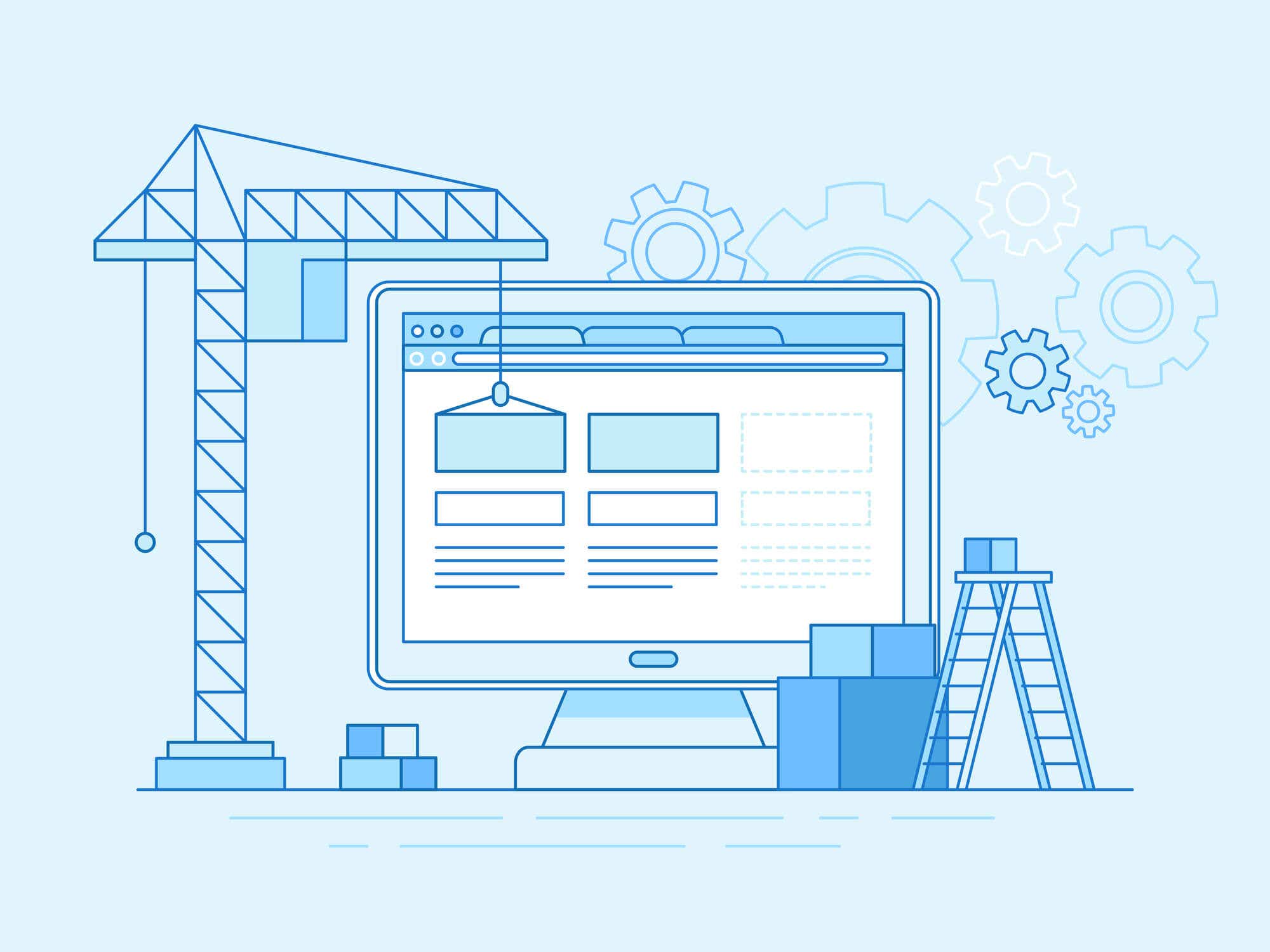Mengobrol dengan Ava - Konsultan AI Bisnis Anda
Hai Saya adalah Ava, AI pemandu Anda untuk meningkatkan bisnis Anda!
Baik Anda telah menjalankan bisnis atau sedang memimpikan untuk memulai, saya di sini untuk membantu mewujudkan impian Anda menjadi kenyataan menggunakan freelancer yang didukung AI. Beritahukan target bisnis Anda, dan bersama kita akan membuat proyek yang bisa ditawar oleh para freelancer berbakat. Mari kita wujudkan impian Anda!
Saya memiliki bisnis
Saya sedang memulai sebuah bisnis
Ada sesuatu yang salah saat mengirim percakapan ke email Anda. Silakan coba lagi nanti.
Anda hanya bisa menyimpan percakapan Anda sekali setiap jam. Silakan coba lagi nanti.
Percakapan Anda terlalu pendek. Teruslah mengobrol dengan Ava agar bisa disimpan.
The ultimate guide to hiring a web developer in 2021
If you want to stay competitive in 2021, you need a high quality website. Learn how to hire the best possible web developer for your business fast.
1 Mei 2019 • Bacaan 10 menit
Diperbarui pada 29 Apr 2021 oleh Product Knowledge T.

Product Knowledge Specialist at Freelancer.com
Gagal menyalin ke clipboard, silakan coba lagi setelah mengubah izin Anda.
Salin ke clipboard.

Your business needs a website, and hiring a web developer will help you build one.
And if you already have a website, you need to constantly stay ahead of your competition by improving and maintaining your online presence.
Whether you're building a website or already have one, you're going to need the help of a web developer.
How much does it cost to build a website?
The cost of web development will depend on the solution you choose. There are a number of solutions available to get your website built.
Cost of hiring a web developer
Solution | Cost |
|---|---|
Solution | Cost |
Solution | Cost |
Solution | Cost |
Solution | Cost |
Hiring in-house
Depending on your needs, you may have to hire a full-time web developer. If your primary business is your website, a full-time in-house developer could be your best solution. After all, if you're a tech platform, your site will need constant development and maintenance.
However, web developers don't come cheap. According to Glassdoor, the average base pay for a web developer is $75,487 USD per year. The cost you incur will also depend on whether you need both a front end and back end developer, or if you're able to find a full stack developer. Also, if you need a web developer quickly you'll need to keep in mind that the hiring process can take 6–8 weeks.
Hiring an agency
An agency can deliver you a custom-built and designed website with the exact functionality you're looking for. They can work with you to determine the way your site looks, how users will navigate through it and the features it offers.
A custom-built site from an agency can be pricey. Expect to pay $10,000–15,000 USD for a simple site, and $20,000–40,000 USD for a site with sophisticated functionality. Also, working with an agency means your job will be handled by an account manager who will liaise with the agency's developers and designers. You're not likely to have direct access to the people actually working on your project.
Software as a Solution (SaaS)
There are software platforms that will allow you to build a website without web design or development skills. Services such as Squarespace and Wix use templates to make web design easy for novices. Most of these services charge a monthly subscription fee.
SaaS platforms can be a good option if you're after a simple website with limited functionality. However, if you want a more customized site or more sophisticated features, SaaS platforms might not deliver the scale of customization you're after. Sites like Squarespace offer plans ranging from $12–40 USD per month.
Freelance Website Design Experts
Hiring a freelance web developer
A freelance web developer can build your website from the ground up. You can find a specialized developer who can work on both the front end and back end of your site to deliver the look and functionality you need.
Freelance web developers offer the customization of agencies or in-house developers, but at a fraction of the cost. The average cost of a completed web development project on Freelancer is $294.06.
You'll also have direct communication with a freelance web developer, so can keep tabs on your project at every stage of the process.
You can find a good freelance web developer by paying attention to their previous reviews. You can see at a glance the number of projects they've completed on time and on budget, as well as how well they communicate with their clients.
Why do I need web development?
As mentioned above, web development is crucial whether you're looking to build a website, or if you already have one.
Why you need a website
Now that you know the cost of building a website, let's have a look at the return you can expect on that investment. The stats below show why building a website is a worthwhile investment for your business.

Having a website for your business is non-negotiable in 2021. Whether you're a large or small business, a web presence gives you a serious competitive edge. A report from Deloitte found that digitally advanced small businesses:
Earned twice as much revenue per employee
Experienced nearly four times as much revenue growth year-on-year
Were nearly three times more likely to have created jobs over the previous year
Had an average employment growth rate more than six times as high
Were three times as likely to have exported products over the previous year
Add to this the fact that 30% of consumers won't even consider a business that doesn't have a website, and it's clear that a web presence is the bare minimum you need to compete.
But having a web presence alone isn't enough. You need a website that engages your customers and stands apart from your competition. It should be visually appealing, easy to navigate, clearly communicate the products or services your brand offers and it needs to work on every internet browser.
While good design is crucial for your website (and you can read more about website design here ), web development ensures your website design will actually function.
Web developers versus web designers
Web designers and web developers fulfill different functions. While you may be fortunate enough to find a designer who also does development, or vice versa, odds are you'll need the services of both.
A web designer will help you do things like set the color palette, layout, imagery and structure of your website. They'll work with you to make your website a good representation of your brand, and to make it easy for users to navigate.
A web developer will take the work done by a web designer and implement it, along with a variety of other tasks to make your website function. In other words, a web designer can make your website visually appealing and easy to navigate. A developer will make it work.
What is web development?
Web development is the process of building web applications to be hosted on the internet or intranet. It's coding that helps a website function.
Web development generally consists of front end development and back end development . This can be broken down into client-side coding and server-side coding. The difference between these is where the processing is taking place.
Websites run on three different components: a client (the web browser), a server and a database.
Client-side coding
Client-side coding, also called client-side scripting, is coding that runs on the end user's computer. This code is used by a web browser to render what the user sees on a web page.
When a user visits a website, their web browser downloads the client-side code and interprets it as the web page they see.
Client-side scripting is easy to see in action. Whenever you land on a webpage, the look and feel of the site is determined by client-side scripting. The client — your web browser — is reading programming language and interpreting it as a web page.
Server-side coding
Server-side script enables websites to have functions like saving a user's data, retrieving saved data and delivering a customized experience. It gives websites function beyond just displaying static content.
Server-side scripting calls information that can be used on a website from a permanent storage database. It can also change information on that database. For example, if you create a log-in for your online banking account, server-side scripting saves new information on a database. The next time you log into that account, server-side scripting calls your information from the database where it was stored.
You can see server-side scripting in action any time you type a search query into Google. When you land on Google's search page, client-side scripting delivers the familiar logo and search bar. But when you type in a query and hit search, server-side scripting delivers the results you see.
Client-side and server-side scripting work hand-in-hand to deliver the experience you have on a website. This is usually a seamless experience, thanks to technologies like AJAX, or Asynchronous JavaScript and XML. This allows the website to query the server for information or functions without reloading a page. It means client-side script and server-side script can work together without the user being aware of all the dynamic changes happening in the background.
Featured Work in Website Design
What does a web developer do?
A web developer does everything involved in building your site except the graphic design (although some developers may also do design, and some designers may be skilled at development).
Some of the things a web developer will do for your site include:
Building your architecture
Web developers help put together your website's architecture. How do users navigate your site? How does one page relate to another page? Where is information housed? What permissions do users need to access certain areas of the site? Your site's architecture helps determine the experience a user has, whether they'll stay on your site and whether they'll want to visit again.
Building your functionality
Your site's functionality determines what it will actually do for users who visit. If you're an online retailer, you'll need functions to allow people to shop, save items, pay and provide shipping information. If you're selling a service, you may need a way for clients to provide you their contact information for lead generation. Any function you want your site to perform will need web development.
Functionality is not only what your site performs, but also the way it performs. Details like page load speed and browser compatibility form part of your site's functionality. A web developer will make sure your site functions seamlessly and reliably across a range of platforms
Testing your website
Web developers will also test the functionality of your website before introducing new functions. They'll make sure that any new features you add don't cause your site to break, and make sure all the existing functions are working.
Maintaining your website
After building the functionality and architecture of your website, a web developer will also help you maintain your site to ensure it continues functioning in the future.
What is front end web development?
Front-end web development is developing the graphic interface users will interact with when they visit a website. It involves writing client-side scripts to be interpreted by web browsers. Front-end development uses HTML, CSS and JavaScript to determine the content, appearance and functionality of a website.
What is back end web development?
Back end web development involves writing server-side scripts to communicate between the database and the user's browser. It uses languages such as PHP, Python and Ruby to connect your website to the database holding all its information. Back end development is the behind the scenes functionality of a website that takes it from being a static page to a dynamic and functional site that users can interact with.
What is full stack web development?
Full stack development is development of both the front and back end. A full stack developer can write both the client-side and server-side scripts of your website.
How long does it take to learn web development?
The basics of web development can be learned fairly quickly. HTML, CSS and JavaScript are relatively simple coding languages, and you can get a good grasp of them in a short amount of time.
There are a wealth of both free courses and coding bootcamps that aim to teach basic front end web development to beginners. Coding bootcamps generally last 8–12 weeks, while free online courses can be done at your own pace.
However, these are just the basics of web development. While you may be able to become proficient in front end coding within 3–4 months, learning the intricacies of back end coding could take around 9–12 months. And as technology develops, new programming languages are introduced and existing languages are refined. In this regard, learning web development is a lifelong process.
Unless you're willing to devote a significant amount of time to learning both front end and back end coding, it's likely you'll want to find another solution to get your website built.
Freelance Website Design Experts
What tools do web developers use?
Web developers work primarily with programming languages to build the structure, look and functionality of a website. They may also use software tools to help them in their process.
Software tools
Web developers can use software for a variety of functions to help them in their work. They may use tools to help them document their code, tools to help compile code, code editing platforms or even visual editors.
Programming languages
Websites run on a markup language called HTML. HTML dictates the content on the webpage. Other coding languages called CSS and JavaScript can be embedded in HTML. These languages give a webpage more functionality. CSS is a markup language that describes how elements are displayed on a screen. It's responsible for the colors, fonts, layout and visual style of a webpage. JavaScript is a programming language that describes what a website does. It's responsible for the functions a website can carry out.
An easy way to think of HTML, CSS and JavaScript is that HTML determines the structure of a site, CSS determines the way a site is presented and JavaScript determines the way a site works.
HTML, CSS and JavaScript are client-side coding languages. But a website also has to interact with a server in order to provide a customized experience for users. For this, web developers use server-side programming languages.
Server-side programming languages include things like Python, PHP, Perl, Ruby, ASP.NET and Lua.
How do I hire a freelance web developer?
Freelance web developers are a good solution if you need to build a website, upgrade a website or even provide some support to an existing web development team for a special project. Hiring a freelance web developer is easy.
Determine your needs
First think about what you need to achieve. Are you building a website from scratch? Do you need a front end and back end developer, or maybe a full stack developer? Will you also need the services of a web designer ?
You'll also need to think about what you want your website to achieve. How do you want users to engage with it? Determine the functionality you need built.
Write a detailed brief
Once you have a good idea of what your website project entails, write it all out in a detailed brief. Be sure to include what skills you're looking for, the budget for your project, the timeframe in which you need it delivered and the finished product you're looking for. Be as detailed as possible.
Post your project
Next, click on the orange "Post a Project" button. Fill in the project details with the brief you've written. You should start receiving bids from freelancers within minutes.
Select your freelancer
Once you've received some bids, look for the freelancer who best fits the experience, skills and budget you're looking for. Pay attention to their reviews. This will give you an indication of how they've performed on previous projects, including if they've delivered on budget and on time.
Also keep an eye out for Preferred Freelancers . These are freelance workers who have completed a high number of projects and received excellent reviews for their work. If you're having trouble sorting through freelancer bids, you can also use a Recruiter to handpick top freelance web developers for your project.
Keep in contact
Once you've found the right freelance web developer, accept their bid to begin your project. Your freelance web developer will keep in contact with you throughout the process to let you know how they're progressing, and to ask any necessary questions.
Once your website is complete, make sure to leave a review for your freelancer.
Featured Work in Website Design
Cerita Terkait
Berbicaralah dengan salah satu Kopilot Teknis kami untuk membantu dalam proyek Anda
Artikel yang Disarankan Hanya untuk Anda

Learn the complete end-to-end process of building a successful website for your business in our comprehensive guide
19 min read

Wireframe creation is critical to website design, but it doesn't need to be complicated. We will teach the stress-free process.
5 min read

Follow this guide to help you design a beautiful website your visitors will love
14 min read

Need to write content for your website? Follow our guide to make sure it's optimized to rank on the first page of Google
20 min read
Terima kasih! Kami telah mengirim Anda email untuk mengklaim kredit gratis Anda.
Anda sesuatu yang salah saat mengirimkan Anda email. Silakan coba lagi.
Memuat pratinjau
Izin diberikan untuk Geolokasi.
Sesi login Anda telah kedaluwarsa dan Anda sudah keluar. Silakan login kembali.










































